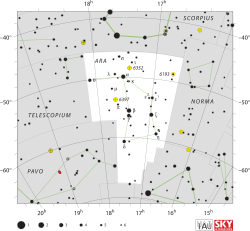Sigma Arae
| Observation data Epoch J2000 Equinox J2000 |
|
|---|---|
| Constellation | Ara |
| Right ascension | 17h 35m 39.58957s |
| Declination | –46° 30′ 20.4618″ |
| Apparent magnitude (V) | +4.575 |
| Characteristics | |
| Spectral type | A0 V |
| U−B color index | –0.064 |
| B−V color index | –0.027 |
| Astrometry | |
| Proper motion (μ) |
RA: –25.78 mas/yr Dec.: –38.30 mas/yr |
| Parallax (π) | 8.62 ± 0.26mas |
| Distance | 380 ± 10 ly (116 ± 3 pc) |
| Absolute magnitude (MV) | 1.40 |
| Details | |
| Luminosity (bolometric) | 26.4 L☉ |
| Temperature | 9,790 K |
| Other designations | |
| Database references | |
| SIMBAD | data |
Sigma Arae (σ Ara, σ Arae) is the Bayer designation for a star in the southern constellation of Ara. It is visible to the naked eye with an apparent visual magnitude of +4.575. The distance to this star, based upon an annual parallax shift of 8.62 mas, is around 380 light-years (120 parsecs).
This is an A-type main sequence star with a stellar classification of A0 V. Unusually for an A-type star, X-ray emissions with a luminosity of 4.6 × 1029 erg s−1 have been detected from Sigma Arae. Normally this is explained by the presence of a lower mass orbiting companion star. However, such a scenario does not appear to hold true for this star. Instead, the signature of a surface magnetic field has been detected with a strength of roughly 128 ± 73 Gauss, indicating the source of the X-rays may be surface magnetic activity.
...
Wikipedia

